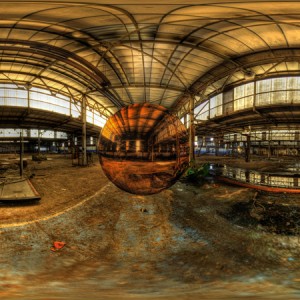
Santa Fe Complex Closes. Stephen Guerin on Hybridity’s Lessons.
When the Santa Fe Complex closes this Friday night in Santa Fe, it will be capping off a four-year run in which the organization, with support from the City of Santa Fe’s economic development arm, gave a bricks-and-mortar locus to projects intended to model working hybrids of technology, science and art. Now, founding director and board chairman Stephen Guerin reflected in a telephone conversation Thursday, the physical Santa Fe Complex will no longer exist, but potential for a rethought organization that lives between a traditional nonprofit structure and a “social benefit” for-profit may yet ensue.
“All the entrepreneurs bringing projects to the Complex are still here,” Guerin said.
Over three years, from 2008 to now, the city of Santa Fe was the majority funder of Santa Fe Complex’s operating costs. Santa Fe city funding for three consecutive years amounted to about $360,000 on a $390,000 commitment. Santa Fe Complex also raised smaller periodic sums from McCune Foundation, said Guerin.
Its key members were technologists such as Guerin himself, whose company Redfish grew a new entity, SimTable, an interactive fire simulator that models the activities of wildfire using actual conditions of neighborhood and terrain. Former Complex board member Richard Lowenberg developed 1st-Mile Institute to extend broadband access to rural New Mexico (listed under the “Projects” tab on the Complex’s website.)

The Complex worked with IAIA's digital dome on a grant researching projections on non-uniform surfaces.
Art projects included “Media Hive,” a monthly event; as well as readings; art exhibits including artists-in-residence; AIGA design workshops; and collaborations including one in which SFeComplex worked with the University of New Mexico and the Institute of American Indian Arts for a $600k dome research grant, to study projections on domed surfaces.
Last fall, Lowenberg convened several local arts entities to collaborate on a letter of inquiry that would have made Santa Fe Complex lead applicant on an ArtPlaceAmerica grant.
So is the Complex’s closure ultimately a comment that the model of science and art hybridity is not, actually, feasible?
“We don’t have a strong need for pure scientists and we don’t have a strong need for pure artists.
Guerin stressed that the foundation of the Complex put technology as equal partner with “science” and “art” – and he said we need to be mindful that now as then, northern New Mexico is a world leader in simulation and visualization of complex systems.
Organizationally, Guerin cited a “no man’s land in structure”, in that the Complex neither fully embraced the culture of a 501(c)3 nonprofit, in which boards in fundraising parlance “give (money), get or get off,” or a for-profit by which innovation successes are measured in a positive-trending bottom line.
“Almost by design we didn’t have a fundraising board,” Guerin said. “The challenge was, we wanted people making a living but didn’t want (the Complex) to be a centralized organization.”
Some people did, as it turns out, make a living – and bring in, as Guerin cited, more than $1.1 million in out-of-state and out-of-country economic devleopment to Santa Fe, “not just recycling dollars,” he said. Successful projects that emerged out of the Complex included programming smart phones for the city of Boston; and making “self-organizing” city-focused applications for Venice, Italy.
Staff functions, said Guerin, were event management and space management. The last executive director, Roy Wroth, departed the post in April. The urbanist idea of renting desks and promoting a co-working culture at the Complex did not prove successful; “demand was not there,” Guerin said. (Wayne Nichols at Second Street Studios is trying the model now.)

Transient Reflection, from Ghosts in Armour
In the art-science-technology structure, Guerin specified that he was most proud of the Complex’s modeling of strong new forms of hybridity, which he contrasted to “the weak form, such as when a physicist tells an artist, ‘here’s what quantum theory is,’ and an artist tries to represent it, or going the other way, when an artist asks, ‘what can I do with magnetism?’”
Strong forms of hybridity, per Guerin’s description, manifest within a single person the characteristics of a new thinker. He cited four now-college students who grew up, effectively, at the Complex, while in high school in Santa Fe.
“We don’t have a strong need for pure scientists and we don’t have a strong need for pure artists. My preference is not to have a great technologist either. We want all three in a single person, and one to vector another.”
Technology moves so rapidly now it takes a whole community to keep up, Guerin said.
“If you have the traditional mindset, you say, ‘where are the jobs,’ and there are very few that have career potential. (In Santa Fe) you have tourism and retail and government and you have some gallery management, but if you change your perspective, it goes back to the freelance notion.” Such a freelance notion is collaborative. “If you can get on a project, it may be a world-class project that may not hire employees, but would pay high-wage labor.”
As that hybrid extends itself out from the sciences to the arts, however, are artists ready? Is there something to the culture of artists accustomed to competing for single grant opportunities, not quite in step with the culture of scientists and technologists, realizing each is part of a “high-wage” labor pool?
The question, says 1st-Mile Institute founder Richard Lowenberg, goes to how tough a job it is to be a future thinker now.
“There’s not an inititative being discussed that isn’t facing the same problematic issue of how do you sustain future-serving efforts in this community at this time, in this nation?
“What are the best practices and very pragmatically, what’s going on and where do we tap into this in ways that are productive?”
Santa Fe residents are invited to come out for the closing reception for Santa Fe Complex, for the Ghosts in Armour show from 6-10 p.m.
